This Japanese cotton cake recipe, also known as Japanese soufflé cheesecake makes a jiggly and fluffy cheesecake with a lovely light and spongy texture, somewhat like a combination of a classic baked cheesecake like a New York cheesecake and chiffon cake. The cake is not overly sweet and has a rich and creamy taste with a delicious hint of tanginess from the cheese.
Given the soft and spongy texture of the cake, some even call this cake a fluffy jiggly cheesecake.

Having made this Japanese jiggly cotton cheesecake a good number of times now, I have come to learn that, while mixing the batter is not much of an issue, the oven setting (temperature and rack position) and the way in which this Japanese cheesecake is cooled play a crucial role in how it turns out.
Jump to:
❤️Why you will love this recipe
- This recipes makes a light and fluffy cheesecake. The texture is similar to that of a chiffon cake or an angel food cake.
- It requires only basic ingredients and those that are easily available.
- The cake is delicious on its own or with a simple dredge of icing sugar. It also makes a great dessert and can be served with fruits.
📋Ingredients
These are the ingredients that go into this fluffy Japanese cotton cake:
- Cream cheese - use full fat cream cheese and not the spreadable kind. Make sure it is at room temperature. Cut into small pieces for easy melting.
- Butter - I use salted butter, also at room temperature. Cut in similar sizes as the cream cheese for consistent melting.
- Milk - use whole milk for a rich cake.
- Egg yolks - use large eggs.
- Lemon juice - use juice from fresh lemons, and strain away the seeds and pulp.
- All purpose flour + corn flour (corn starch) + salt - mix together and sift first before adding into the cake batter.
- Egg whites - use large eggs
- Granulated sugar (caster sugar) - adds sweetness to the cake. Sugar must be fine to avoid deflating the whipped egg whites.
- Cream of tartar - helps stabilize the egg whites.
- Powdered sugar - for the topping, after baking.
Though the list looks pretty long, the ingredients are pretty common ones, nevertheless.
*Refer to the recipe card below for full list of ingredients and exact quantities. For best results, use a digital kitchen scale where applicable*
🧾Substitution and Variations
- All purpose flour can be substituted with cake flour. Both have low gluten content and are suitable for making this cotton cheesecake. Always remember to sift the flour to break any lumps or it will affect the texture of the cake.
- Salted butter can be substituted with unsalted butter.
- Milk can be replaced with heavy cream. It will add richness to the cake.
- Instead of plain powdered sugar dredge, the cake can be topped seasonal fruits and berries for a lovely dessert.
This recipe has not been tested with other substitutions or variations. If you do try, please let me know in the comments section below!
👩🍳How to Make
Mixing the cake batter
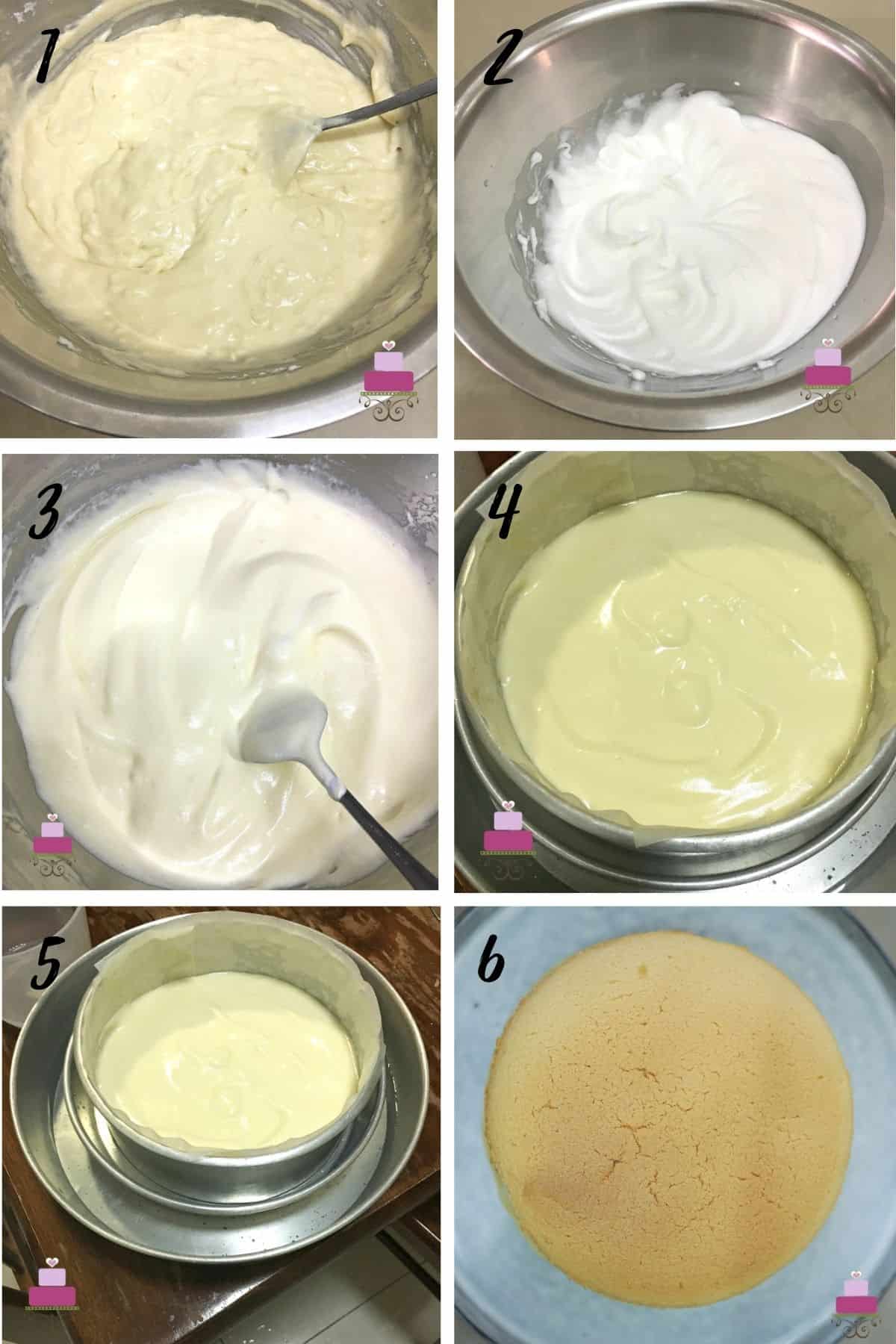
- The fluffy and jiggly texture of this Japanese cotton cake is contributed by the way the batter is mixed, i.e. in 2 parts. The first part, add the cream cheese, butter and milk into a heatproof bowl. Place the bowl over a pot of water (without touching the water) and double boil until the cheese are butter are melted and smooth. Remove from heat and set it aside to cool down. Separately, whisk the egg yolks and lemon juice. Add the egg yolks mixture into the cheese mixture and whisk until it forms a smooth and creamy mixture. Sift in the flour, salt and corn flour and fold until well incorporated. Set this aside.
- The second part is to whisk egg whites. Add the egg whites and cream of tartar in a grease free bowl. Whisk (with a whisk attachment) until the egg whites turn frothy. Gradually add the sugar, whisking continuously until the sugar is all added in and the egg whites reach a soft peaks stage.
- Fold the egg whites into the cream cheese batter gradually to form the light Japanese cotton cream cheese mixture.
- Pour the batter into a prepared cake pan (parchment paper lined) and bake in a water bath (on the lowest rack in your oven). Make sure to line both the sides and bottom of the pan.
- With a springform pan, placing it directly in a pan filled with water (for the hot water bath) will result in water seeping into the tin and batter from the bottom. To avoid that, most people would wrap their cake tins with aluminum foil before placing them into the water-filled pan. I chose not to wrap my cake tin with foil. Instead, I place my cake tin in a slightly larger cake tin and place both into the water bath. This way, water will never seeps into my cake. And I save the hassle of having to wrap the foil around my cake tin.
- Once the cake is baked, turn off the oven but leave the cake in the oven for 10 minutes. Leave the cake to cool in the oven for another 10 to 15 minutes with the oven door ajar before removing and turning it out of the cake tin onto a wire rack.
Decorating the cake
This is a super simple decorating idea for a jiggly Japanese cheesecake.
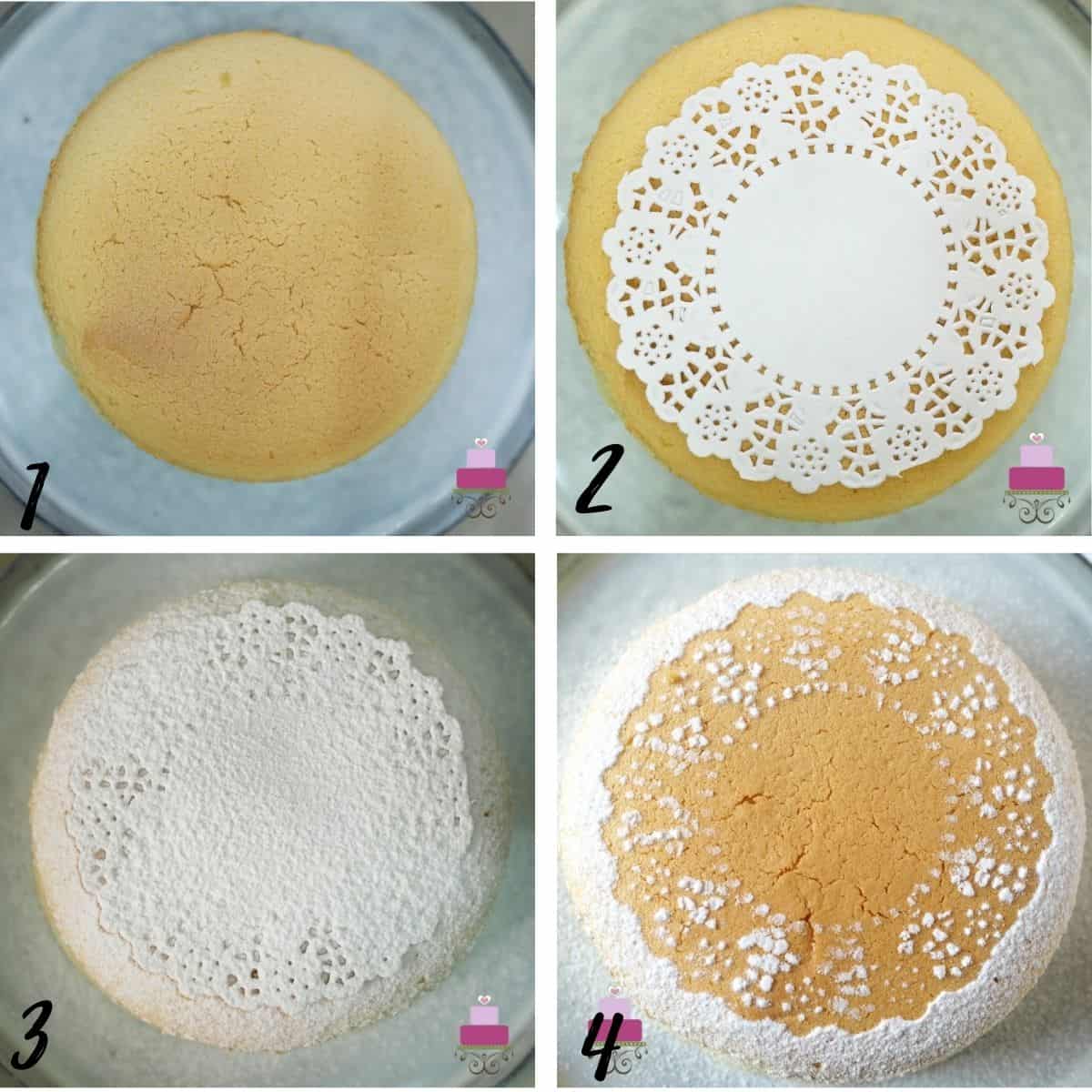
- Start by placing the cheesecake onto a serving plate and place a doily on the cake. It is best to use a doily that is of the same size as the cake.
- Use a sieve to sift a layer of powdered sugar on the doily. Make sure to cover the entire cake top. Also, make sure the doily does not move as you sift the powdered sugar on.
- Once done, remove the doily off the cake top very carefully. Make sure none of the powdered sugar on the doily drops on the cake top. And you will get a lovely icing sugar lace pattern on your Japanese cotton cake.
- You can add some fruits or even fruit filings to the cake if you wish. Otherwise, serving it plain with the simple sugar dredge, it is perfect for this lovely, fluffy, jiggly Japanese souffle cheesecake.
🍽️Serving & storage
- The cake is best served after it has completely cooled down, so that the powdered sugar dredge on top does not get melted.
- Left overs can be stored at room temperature for at least 3 days but keep it in an airtight container.
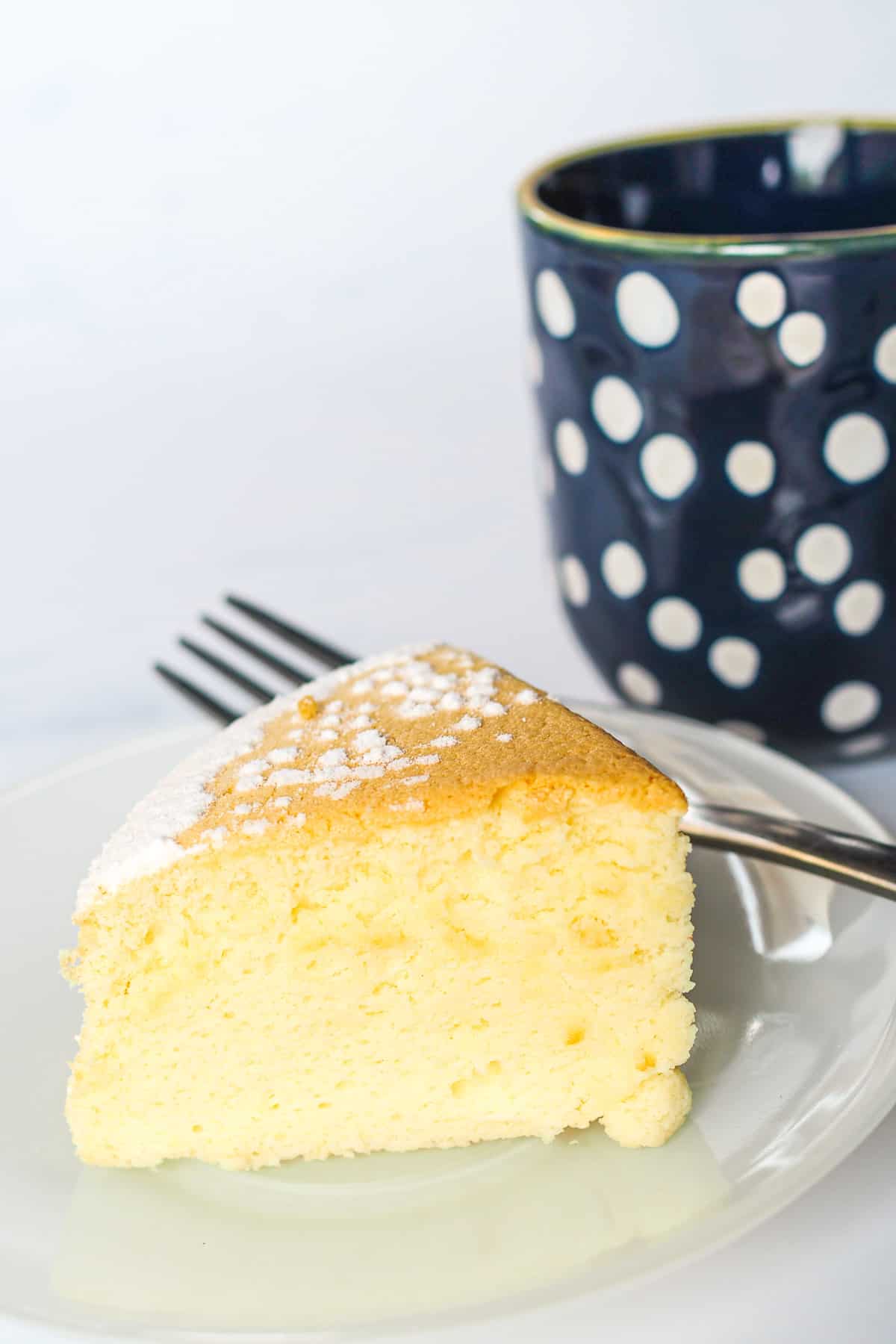
💡Expert Tips
Baking this soft and fluffy Japanese cotton cake can be a little daunting for some people. The most common issues are cracked tops or cakes that rise so well in the oven but totally collapse once they are out of the oven.
I have had my fair share of failures for this delicate Japanese cotton cake, and after many rounds of trials and errors, I have come to learn that the following factors play an important role in how a Japanese cotton cake turns out.
Water Bath
- A water bath or bain-marie is a process of baking by placing the baking pan in a baking dish filled with water in the oven. The water will help keep the interior of the oven moist, preventing cakes from drying out as they cook and potentially avoids cracks (especially for cheesecakes).
- When using a spring-form pan, to avoid water from the baking dish seeping into the cake, you can wrap the sides of your pan securely with foil and then place it in the water-filled baking dish.
- The other way is to place your springform tin in another slightly larger baking tray and then place both in a water-filled baking dish. This will also prevent the water from seeping into this Japanese cotton cake as it is baking.
Oven temperature
- This cotton cake requires the oven temperature to be adjusted halfway through baking, just like some fruit cakes.
- You start with a slightly lower than normal baking temperature at about 140 degrees Celsius (284 degrees F) for 15 minutes and then you lower the temperature to 125 degrees Celsius (260 degrees F) for another 55 minutes.
- The baking time is also generally longer compared to normal cakes but you will notice that the temperature is much lower than other cakes.
Oven rack position
- The position in which you place this Japanese cotton cake in the oven also plays an important role. Ideally, the rack position for this cake should be the lowest in your oven. This is to avoid the top of the cake from browning too much.
Moisture in the oven during baking
- Similar to cheesecakes, this fluffy cake must be baked in a water bath. This is to help retain moisture in the oven and this helps the cake remain moist after baking.
This cotton cake must be gradually cooled off
- Once the cake is baked, turn off the oven, but leave the cake in the oven for a good 10 minutes. After that, open the oven door slightly and continue to let the cake cool in the warm oven for another 10 to 15 minutes.
- Only after that should the Japanese cotton cake be removed and cooled at room temperature. This gradual cooling off is to avoid the cake top from wrinkles due to sudden changes in temperature.
In a nutshell, since too much heat will cause the Japanese cotton cheesecake top to crack, the baking temperature is lowered. And because of the lower temperature, the cake generally takes a longer time to cook. To counter the effect of the cake drying out due to longer baking time, a water bath is required.
💭FAQs
Other names for this cake are Japanese soufflé cheesecake, cotton sponge cake, sponge cheesecake, cotton jiggly cake, Japanese light cheesecake and Japanese soft cheesecake.
It is a marriage between a chiffon or sponge cake and cheesecake. Unlike a typical chiffon cake, the Japanese cheesecake is made using cream cheese but maintains a light, soft and cottony texture of a chiffon cake. It is also baked in a water bath unlike a regular sponge or chiffon cake.
Double boiling is when you cook or melt something with the heat from the steam of boiling water. It is slightly different from the steaming process whereby the food comes directly into contact with the steam. In double boiling, the steam does not touch the food, it merely heats up the bowl or pan in which the food is contained.
To double boil something, you would need at least one saucepan or pot and one heat proof bowl. Ideally, the bowl should be large enough to sit on top of the pot or saucepan without going in and touching the water.
You then fill up the saucepan with water (about one third or half full) and place the heatproof bowl on top. The bowl should not be touching the water underneath, but it should sit directly on the pot. Add the food you intend to double boil (like chocolate or cheese) and heat up the water to melt the chocolate or cheese.
This method is typically used to temper chocolate, and for cooking items that are prone to burning when subjected to direct heat.
❤️More Recipes You Will Love
Do you like this recipe? Please leave a 5-star ⭐⭐⭐⭐⭐rating in the recipe card below and consider a review further down this page. I would love to hear from you. Thank you!
📖Recipe
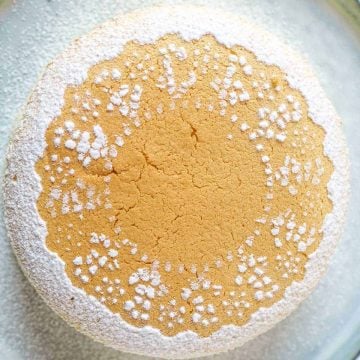
Japanese Cotton Cake (Jiggly & Fluffy Cheesecake)
For best results, use the metrics measurements. US customary measurements have not been tested and are only meant for guide.
Ingredients
- 80 g cream cheese at room temperature
- 20 g butter
- 30 ml milk
- 2 egg yolks
- 1 teaspoon lemon juice
- 15 g all purpose flour
- 15 g corn flour (corn starch)
- 2 egg whites
- 50 g granulated sugar
- ¼ teaspoon salt
- ⅛ teaspoon cream of tartar
Instructions
- Preheat oven to 140°Celsius. Line the sides and bottom of a 6 inches round cake tin with parchment paper. Prepare water bath by filling a larger than 6 inches round cake tin or tray with hot water until the water reaches a height of about 4 to 5 cm. Place the tray in the oven to keep the water hot.
- In a double boiler, melt the cream cheese, butter and milk and stir until the ingredients are well combined and smooth. Set aside.
- In a separate bowl, beat egg yolks and lemon juice to break the yolks and add it to the cream cheese – butter mixture. Whisk until smooth.
- Sift in the all purpose flour and corn flour and fold until the flours are all well incorporated.
- In a clean, grease-free bowl, whisk the egg whites and cream of tartar until frothy. Add the sugar in two parts and continue to whisk the egg whites until it reaches a soft peak stage.
- Drop a spoonful of the whisked egg whites into the cheese-egg yolks mixture and fold it in until well incorporated. Carefully pour the remaining egg whites and continue to fold until all the egg whites have been fully incorporated and there are no more traces of egg whites visible.
- Pour the batter into the prepared tin, level the top, and tap the tin on the countertop a couple of times to remove any air bubbles.
- Place the cake tin in the water bath and bake at 140°Celsius for 15 minutes. Lower the temperature to 125°Celsius and continue baking for another 55 minutes. Once the cake is done, turn off the oven but leave the cake in the oven for 10 minutes. Continue to leave the cake to cool in the oven for another 10 to 15 minutes with the oven door ajar before removing the cake out of the oven. Turn the cake out of the cake tin and let it cool to room temperature.
- The cake can be served plain or with a light dust of powdered sugar. Keep leftovers refrigerated.
Notes
- This is a small batch recipe, yielding a 6 inches round cake. As such the ingredients used are in small quantities too.
- It is best to use a digital kitchen scale to measure these especially the all purpose flour and corn flour, but if you do not have a digital scale, simply scale the recipe up. Double the recipe and bake in an 8 inches round cake tin or triple it and bake in a 9 inches round cake tin.


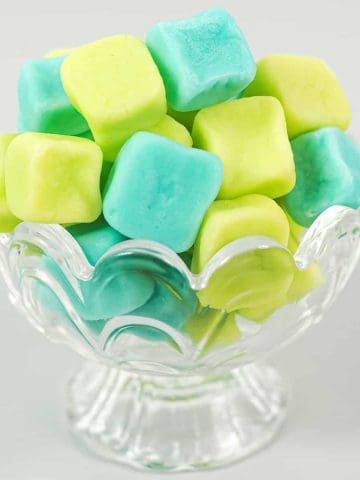
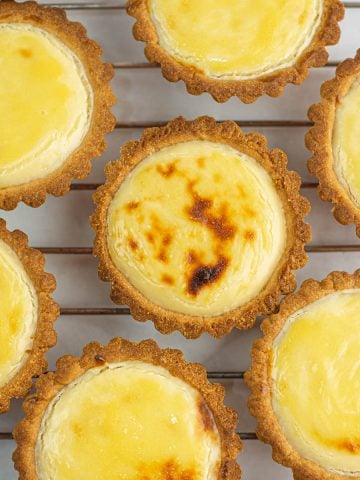
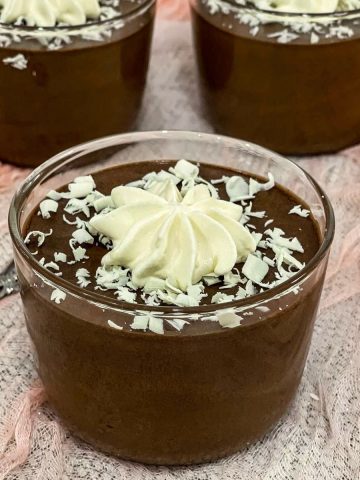
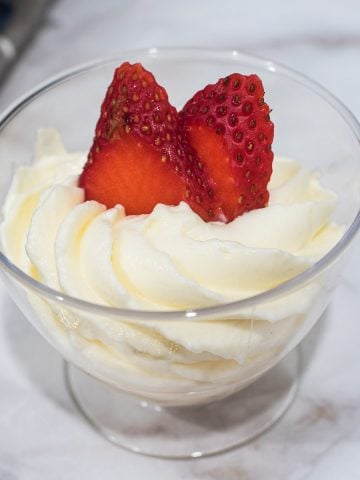
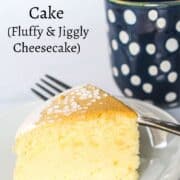
Leave a Reply